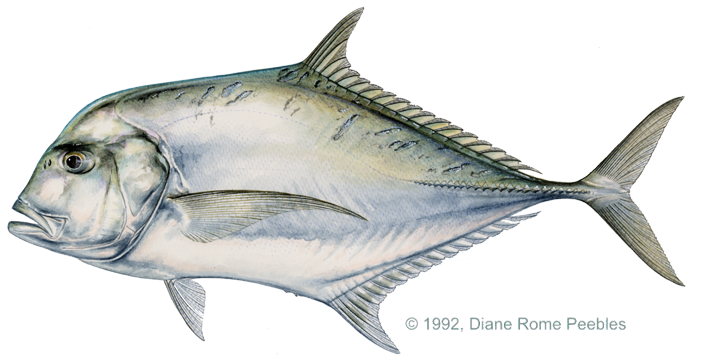Game Fish Identification Reference Guides
Pompano, African
(Alectis ciliaris)
(Alectis ciliaris)

(Bloch, 1787); CARANGIDAE FAMILY; also called Cuban jack, Atlantic threadfin, threadfin, pennantfish, cobblerfish
The African pompano is the largest and most widespread species of the genus Alectis. It can be distinguished from other members of the genus by the lower number of gill rakers on the first branchial arch (18 22 as opposed to 30 35 in A. indicus of the Indo Pacific and even more in A. alexandrinus of Mediterranean and West African waters).
It is characterized by 4 6 elongated, thread like rays in the front part of the second dorsal and anal fins. In juveniles the first two of these rays may be four times as long as the fish. Normally, the rays tend to disappear or erode away as the fish grows. It also undergoes changes in body shape as it grows. The body of juveniles is short and deep. The spines of the first dorsal fin are visible, though not very prominent at this stage. By the time the fish is 14 in (35 36 cm) long, the body is more elongated and the forehead is steeper. In both juveniles and adults of A. ciliaris the body is strongly compressed. The lateral line arches smoothly but steeply above the pectoral fins. Larger specimens are light bluish green above and silvery over most of the remainder of the body. They may have dark blotches on the operculum on the dorsal side of the caudal peduncle, and on the anterior portion of the second dorsal and anal fins.
It is a strong fighter and an excellent light tackle game fish. It will take small live or dead baits, as well as lures, jigs and feathers. It is usually caught incidentally while trolling for other species.
The name African pompano is misleading, since the fish is actually a member of the jack family
The African pompano is the largest and most widespread species of the genus Alectis. It can be distinguished from other members of the genus by the lower number of gill rakers on the first branchial arch (18 22 as opposed to 30 35 in A. indicus of the Indo Pacific and even more in A. alexandrinus of Mediterranean and West African waters).
It is characterized by 4 6 elongated, thread like rays in the front part of the second dorsal and anal fins. In juveniles the first two of these rays may be four times as long as the fish. Normally, the rays tend to disappear or erode away as the fish grows. It also undergoes changes in body shape as it grows. The body of juveniles is short and deep. The spines of the first dorsal fin are visible, though not very prominent at this stage. By the time the fish is 14 in (35 36 cm) long, the body is more elongated and the forehead is steeper. In both juveniles and adults of A. ciliaris the body is strongly compressed. The lateral line arches smoothly but steeply above the pectoral fins. Larger specimens are light bluish green above and silvery over most of the remainder of the body. They may have dark blotches on the operculum on the dorsal side of the caudal peduncle, and on the anterior portion of the second dorsal and anal fins.
It is a strong fighter and an excellent light tackle game fish. It will take small live or dead baits, as well as lures, jigs and feathers. It is usually caught incidentally while trolling for other species.
The name African pompano is misleading, since the fish is actually a member of the jack family












